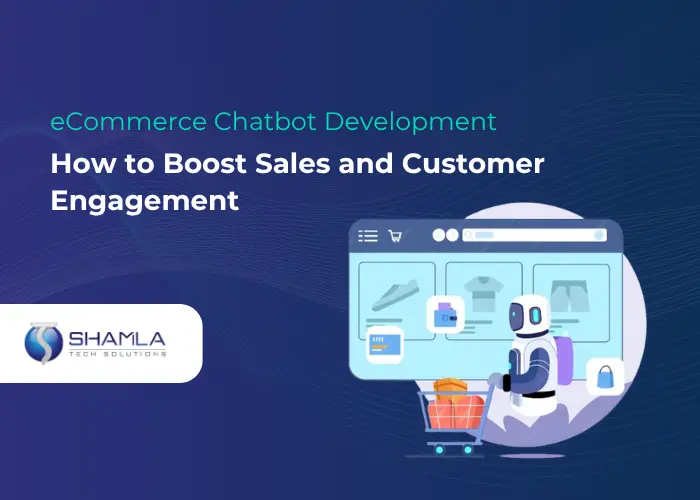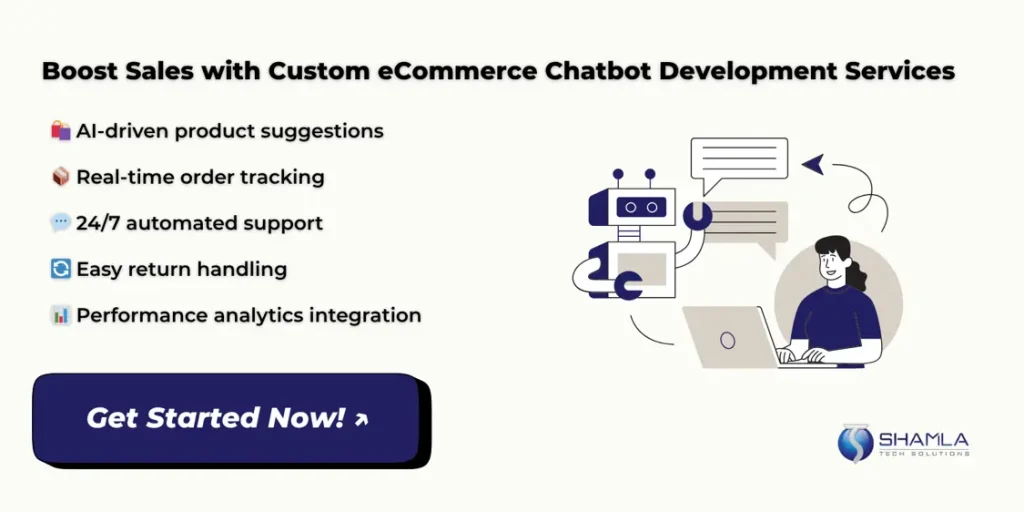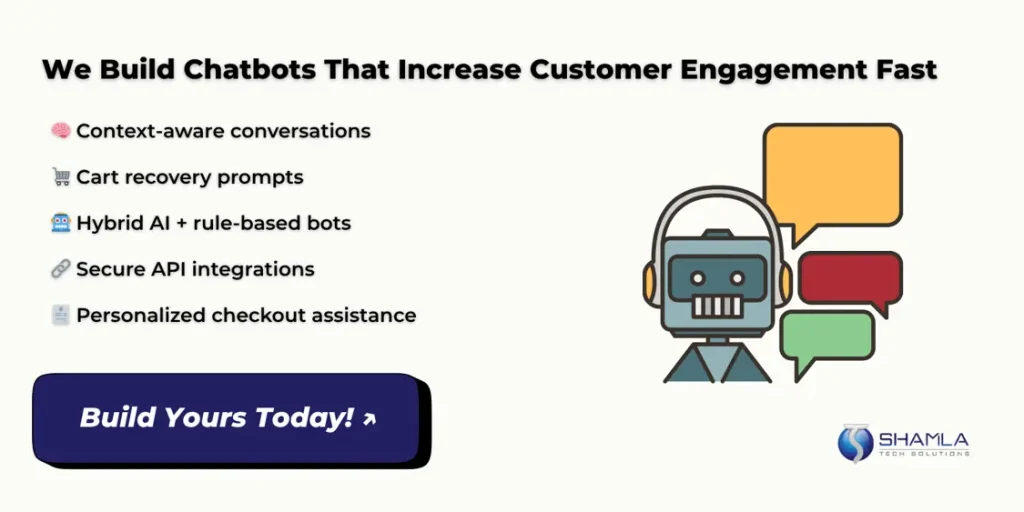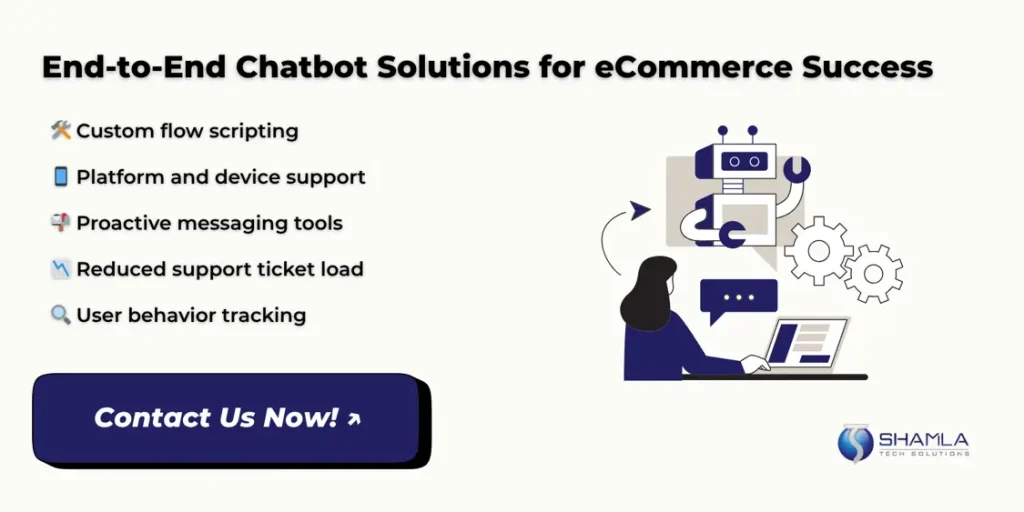Online stores now rely on chatbots for instant help, guiding shoppers through product searches, checkout, and order tracking without delays. Clear planning and set tasks are vital before starting any build. Effective eCommerce chatbot development starts with defined goals, choosing tools that fit, and solid connections to store data.
Modern conversational commerce solutions let users browse, compare, and buy items entirely in a familiar chat window. Laying out each step – from mapping flows to handing off complex cases, ensures the bot works well right away. Below, we’ve listed seven straightforward practices to boost sales, keep customers engaged, track performance, improve service quality, and save time.
7 Best Ecommerce Chatbot Development Practices to Boost Sales and Customer Engagement
1. Define Clear Goals and Metrics
Start by listing each task your bot needs to handle:
- Answer product details and availability queries
- Suggest related items based on user history
- Provide shipping and tracking updates
- Manage returns and refund requests
Align these tasks with clear performance indicators to measure success. Vague aims will waste effort and delay delivery. With clear targets, teams can focus on what matters. Choose simple metrics such as cart abandonment rate, chat resolution rate, conversion rate after chat sessions, and customer satisfaction scores. Embed a single-question survey at the end of each session, for example “Was this chat helpful?” Monitor these key numbers weekly to spot issues early and guide improvements.
In eCommerce chatbot development, tying metrics to business goals shows real value.
For example, reducing cart abandonment by 10% can boost monthly revenue significantly. Conversational commerce solutions that track click rates on recommended products help refine suggestion logic. When chatbot solutions for eCommerce miss targets, revise scripts, add new intents, or adjust fallback messages and calls to action. Regular metric reviews and crystal-clear goals keep development aligned with core objectives and track progress.
2. Map User Flows and Script Paths
Begin by sketching every step a shopper might take, from greeting to exit. In eCommerce chatbot development, missing any path leaves users stranded. Use a simple chart or list to match each user request with a clear bot reply. Include quick-reply buttons like “Track Order,” “Size Guide,” or “Talk to Support” so users don’t type free-form text. These shortcuts make conversational commerce solutions feel responsive and reduce misinterpretation.
Break flows into branches: product search, payment issues, return requests, and human hand-off.
For each branch, define the expected user input, the bot’s reply, and fallback if the bot doesn’t understand. For example, if a customer types “I want to check my order status,” the bot should fetch tracking data – if it fails, it should offer to connect to an agent. Test these maps with real users to spot dead ends or confusing loops.
Well-mapped paths cut resolution time, increase completion rates, and boost trust. When flows work smoothly, your chatbot solutions for eCommerce can handle more interactions without human help. Regularly revisit and refine these maps as new products, policies, or promotions go live, ensuring the bot stays accurate and helpful.
3. Choose the Right Technology Stack
Pick tools that fit your project’s needs and available budget. For straightforward Q&A and menu-based chats, rule-based builders like ManyChat or Chatfuel let you design flows without coding. These platforms handle keywords, quick replies, and basic data collection but can’t track context across multiple turns.
For richer interactions like following up user questions, personalizing suggestions, or accessing order data, use AI platforms such as Dialogflow, Rasa, or an LLM-powered API. These conversational commerce solutions interpret intent, maintain context, and integrate with your product feed via API. Confirm the platform supports secure authentication so it can pull order history safely.
Evaluate each option on integration ease with your store – Shopify, Magento, or a custom system, using REST or webhook connections. Check for built-in analytics or easy hooks into Google Analytics for event tracking. Ensure the tech stack allows version control of flows and easy rollback if a release causes errors.
Choosing the right stack speeds development, lowers maintenance overhead, and scales with traffic spikes. With a solid foundation, your chatbot solutions for eCommerce will stay reliable as features expand and visitor numbers grow.
4. Integrate with Backend Systems
A chatbot’s value depends on live data access. In eCommerce chatbot development, link the bot securely to your order management, inventory, CRM, and analytics platforms. Use API calls to fetch stock levels instantly and confirm order status after verifying user identity. Implement webhooks so the bot sends proactive alerts like – “Your order shipped” or “Price drop on a saved item.”
Allow the bot to update records: create return tickets, log support requests, and push user feedback into your CRM. These conversational commerce solutions make the bot feel like an integrated assistant. For example, a shopper asking for a refund should trigger an auto-generated return label via email or chat link.
Ensure data privacy by encrypting all API traffic and enforcing token-based authentication. Regularly audit access logs for anomalies. Map error codes so the bot can handle failures gracefully, offering retries, apologizing, or escalating to a human.
Strong integration prevents information gaps that frustrate buyers. When systems talk smoothly, your chatbot solutions for eCommerce can automate complex tasks and free up your support team for high-value queries.
5. Craft Simple, Friendly Language
Write short, active sentences in everyday words. Swap phrases like “omnichannel personalization” for “messages on any platform.” In eCommerce chatbot development, shoppers expect quick, clear replies – no jargon or marketing fluff.
Keep most messages under 20 words and split longer instructions into numbered steps or bullet lists:
- “Click ‘View Cart.’”
- “Tap ‘Checkout.’”
- “Enter your promo code.”
Use smart buttons and menus labeled with one action each – “Get Help,” “See Deals,” or “Track Order.” These conversational commerce solutions guide buyers through tasks without guessing. Avoid vague phrases like “our system” or “support team”; refer directly to “me” (the bot) or “a human agent” for clarity.
Test tone with real users to ensure readability on mobile screens. Plain language speeds comprehension, reduces errors, and makes chatbot solutions for eCommerce more approachable.
6. Provide Smart Escalation to Humans
Bots excel at routine tasks but can’t handle every issue. In eCommerce chatbot development, define clear triggers for human hand-off. For example, if a user types “agent,” “talk to human,” or repeats “not helpful,” the bot should say, “I’m connecting you to a person now.”
Route these chats into your live system like live chat, email ticketing, or phone support which will carry over the chat history so customers don’t repeat themselves. Tag each transcript by topic such as returns, billing, or complaints, so agents see context immediately.
Offer an explicit “Help” button throughout the chat. In conversational commerce solutions, this button can appear at any step, preventing dead ends. Ensure hand-offs happen within a defined SLA, like 30 seconds, to maintain trust.
Smooth escalation cuts buyer frustration, improves satisfaction, and balances automation with human empathy. Well-designed hand-offs make chatbot solutions for eCommerce a reliable first contact, not a dead end.
7. Monitor Performance and Iterate
Once live, track chat metrics closely: volume, drop-off points, resolution time, and satisfaction ratings. In eCommerce chatbot development, use built-in dashboards or integrate chat events into Google Analytics. Watch for high exit rates in specific flows like payment, shipping, or returns, to spot friction.
Collect user feedback after each chat with a quick rating prompt. Set weekly review sessions to analyze trends and identify weak spots. For example, if product suggestions underperform, tweak the recommendation logic or update the item feed.
Test different versions of greetings, button text, and promotional messages to see what performs best. Small changes like swapping “See Deals” for “Show Offers”, can easily lift engagement by 15–20%. In conversational commerce solutions, automate reports that compare bot-driven sales versus human-driven sales to measure ROI directly.
Use this data to improve chat flows, add new intents, and remove old or unused scripts. Continuous iteration ensures your chatbot solutions for eCommerce stay sharp, relevant, and aligned with changing customer needs and your expanding product catalog.
Conclusion
Using these listed steps, you can build an eCommerce chatbot that handles product queries, guides shoppers through checkout, updates orders in real time, and hands off complex issues to human agents. This bot will lift sales by suggesting related items, cut support load with instant answers, and boost repeat purchases more efficiently.
Shamla Tech is an eCommerce chatbot development company that has built chatbots for stores worldwide that answer buyer questions, guide product discovery, and automate order updates. Our eCommerce chatbot development solutions have increased purchase rates, cut support requests, and raised repeat visits. Businesses trust our bot systems to drive growth and enhance customer satisfaction.
Want to build your own eCommerce chatbot that drives real sales?
Contact Shamla Tech and Get started today!





